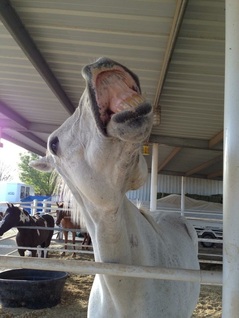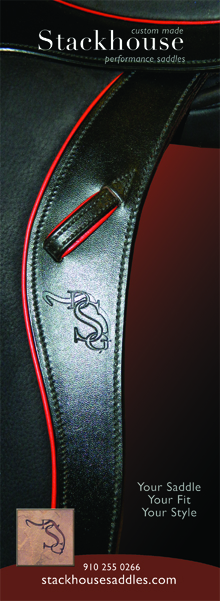Search the Site
Quin's Blog post # 1: Tiny Signals

How many times have you wished that you could read your horse’s mind or longed for a magic spell to make your horse talk, even for just a minute? I don’t know about you, but if I had a penny for every time I’ve made that wish, I’d be a millionaire. Being able to know what a horse is thinking or feeling at a given time would be like the magic key to the equestrian universe, but sadly, no such spell exists. There is something that’s close, however: tiny changes in your horse’s behavior, tiny signals that, when you listen, can be the magic key we all wish for.
Horses communicate with their entire bodies all the time. They use posture, facial expressions, and breathing rate as well as vocalization to communicate with each other, and they use the same system to communicate with us. Sometimes, it’s easy to decipher: a nicker in greeting, ears pinned in annoyance, a flying hind leg as a warning, the fear response of a spook, impatient pawing…. You don’t have to be around horses long to pick up on the basics; my students start to learn to read horse behavior from day one. But sometimes, there’s more to it -- far more than seems possible, in fact -- and if we aren’t paying attention, it’s all too easy to miss the tiny signal that tells us what we need to know.
It was subtle changes in Grimm’s behavior last year that told me he was injured -- even when he was showing as sound on the longe line. A couple weeks ago, it was his uncharacteristic resistance to bending that told me his SI and right hock needed more support for this next stage of his rehabilitation. However, just after that, just after he went back into work with an exuberance that told me in no uncertain terms that his back and hock felt SO much better, Grimm started acting … off.
And it hasn’t been subtle.
In the last couple weeks, his temper tantrums have escalated to monumental levels, hearkening back to the early days of his training. Between tantrums, he’s alternated -- sometimes within the same lap around the arena -- through some of the best work he’s ever offered and some of the worst. Earlier this week, it got to the point that I called the vet in despair. Maybe he was telling me that he just isn’t able to do it. Maybe it just hurts too much to trot at all. Maybe it's time to call it quits.
The vet wasn’t ready to give up. And so, armed with a new regimen of large circles and perhaps some cantering to help him loosen and strengthen his back, with a hefty dose of doubt, I had another ride on Wednesday.
He was … okay. He definitely enjoyed the new plan; it felt like old times, and he tried. He really did. But something was still wrong. He was still had bouts of sulky, angry, and unwilling. And his stride was just as uneven as before. I went home in tears but vowed to give it another day before calling the vet for what I figured was going to be the last consultation. The day after that, Grimm handed me the magic key, and once I figured out what he was saying, I wanted to kick myself seven ways to Sunday.
Even through all of our rough times, Grimm has always been a horse that wants to work. He meets me at the stall door, puts his head in the halter, takes the bridle himself, and stands at the mounting block like a saint. At the beginning though, before I got his back issues under control, he was awful to groom and saddle. He’d fidget, flinch, and kick out when I’d brush with anything harder than a mitt and soft, natural brush. I thought he was just ‘thin-skinned’. When it came time to put the saddle on, it was always complicated by a game of ‘evade the tack’. I figured he was just antsy. Once the saddle was up, he’d almost always do a downward-dog type stretch just before I tightened the girth. I chalked it up to how clever he was, stretching out his back before we went to work. And then he’d toss his head, pin his ears, and gnash his teeth when I girthed him up … but aren’t all racehorses ‘girthy’? I dismissed all of it.
Then, one day, well into his training and after his back issues were under control, I realized he wasn’t doing ANY of that anymore. I could groom him with a curry and brush with all the elbow grease I cared to exert, and he loved it. He stood like a rock so nicely that my ten-year-old students could tack him up for me without a single issue. No stretching, no aggression -- just a quiet, happy horse, ready to go to work. Whenever something starts to bother him, though, those signals come back. Downward dog is his usual; it means he worked too hard yesterday and needs his shoulders stretched. He’s even gotten to the point where he hands me his front feet to do the stretch. Twitching under the brush means he’ll need a longer warm up and maybe some liniment afterward. Big fidgeting is how I know it’s time to consider bute or a dose of muscle relaxers, or maybe it’s time for another back injection. But even when these signals show up, his girthiness is gone. He never pins his ears or gnashes his teeth at the girth.
At least until yesterday.
Yesterday was the day of that moment-of-truth ride I was dreading. I approached it with grim determination (no pun intended) but had braced myself for the final heartbreak that was to come. I’d know after that ride if it was time to pull the plug.
He stood like a rock as I groomed him, as he has done for the last few weeks, even when I brushed him more thoroughly than necessary because I was putting off the inevitable. We had snuggle time, then I put up the saddle. Still he stood like a statue, a perfect gentleman, as usual. Then I attached the girth and pulled up the slack, just as I always do … and he pinned his ears and tossed his head.
What?
I checked over the blanket and girth, stretched his front legs (which he really didn’t seem to care about), bridled him (he reached for the bridle and put it on himself), and led him out, with that tiny signal writhing around in my head. Girthiness. Odd. And I'd missed the obvious.
He warmed up at the walk really, really well. In fact, he was offering his back better and faster than usual, and he felt truly fantastic. My hope rekindled. Then I asked him to trot.
He balked.
Half of my brain went for the worst: the work yesterday was too much and that proves it’s over. But the other half refused to go down that road, and on a whim, I stuck my finger into the gullet of the saddle.
It barely fit.
Somehow, the perfect storm of his changing topline, the regular use of the saddle, my weight, and perhaps the change in the weather has changed the way his saddle fits. The flocking that was adjusted just for him, on his saddle that I had carefully checked just a few weeks ago to be sure it still fit … didn’t. It was too wide and squeezed my finger uncomfortably every step. I nearly cried.
Kicking myself for not having checked it earlier, I got off and took him back to the cross ties. Fortunately, I still have the pad we used to use back at the beginning, when the saddle was too wide for him before. I put it on, checked the fit again, and went back out.
He was reticent at first. Every time I asked for trot, he’d start off reluctant, but then he’d slowly relax and build to a lovely floating trot. After a bit, most of the unevenness in his stride was gone for the first time in weeks. He didn’t throw a single tantrum. We even did a little very, very careful canter. He blew his nose every stride.
So, yesterday was NOT our last ride. But that tiny signal -- that little toss of the head -- could have been so easily overlooked. I could have ignored it, assuming he was just grouchy, and then where would we be? Thank goodness I didn’t.
Too often, we attribute certain behaviors to ‘just the way they are’. But the truth of the matter is that sensitive skin and girthiness are signals, not personality descriptions, and they should not be ignored. Like Grimm, horses who hurt somewhere will often behave poorly when tacking up. It’s usually a saddle fitting issue, but it can also be an indicator of back pain, and when we ignore what they are telling us, we continue to make the problem worse, ride after ride. A saddle fitter and a vet can work wonders, and when we pay attention, it’s as good as knowing what your horse is thinking. Pay attention. Listen. Tiny signals, those little changes in your horse’s behavior, are gold. They’re the closest we’ll ever get to a magic key that lets you understand your horse’s thoughts. Don’t let them slip by unnoticed; your horse is talking to you the only way he knows how.






